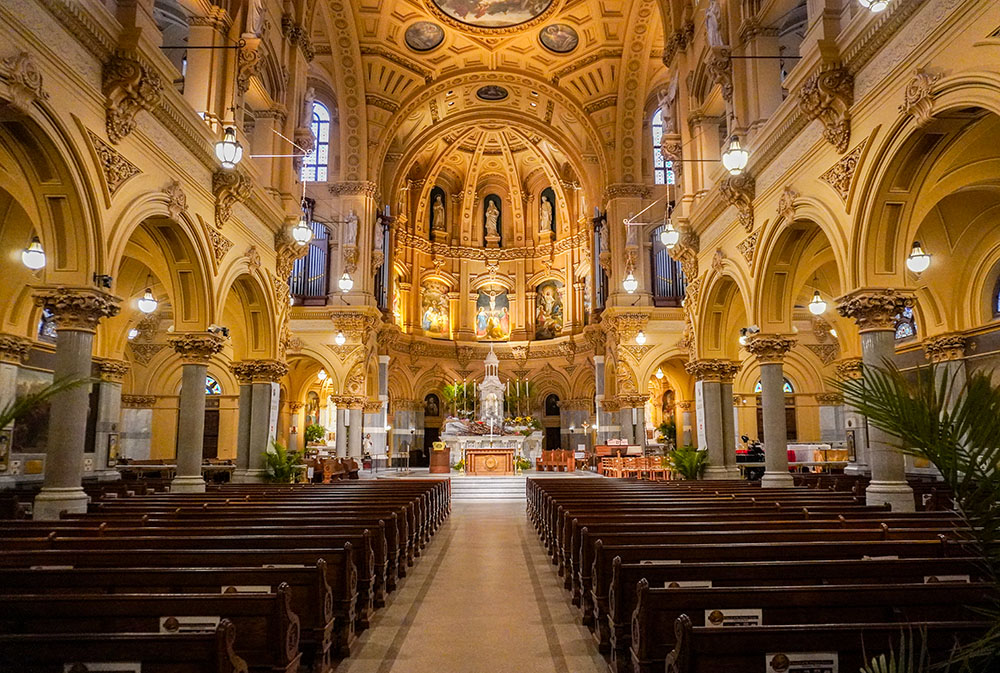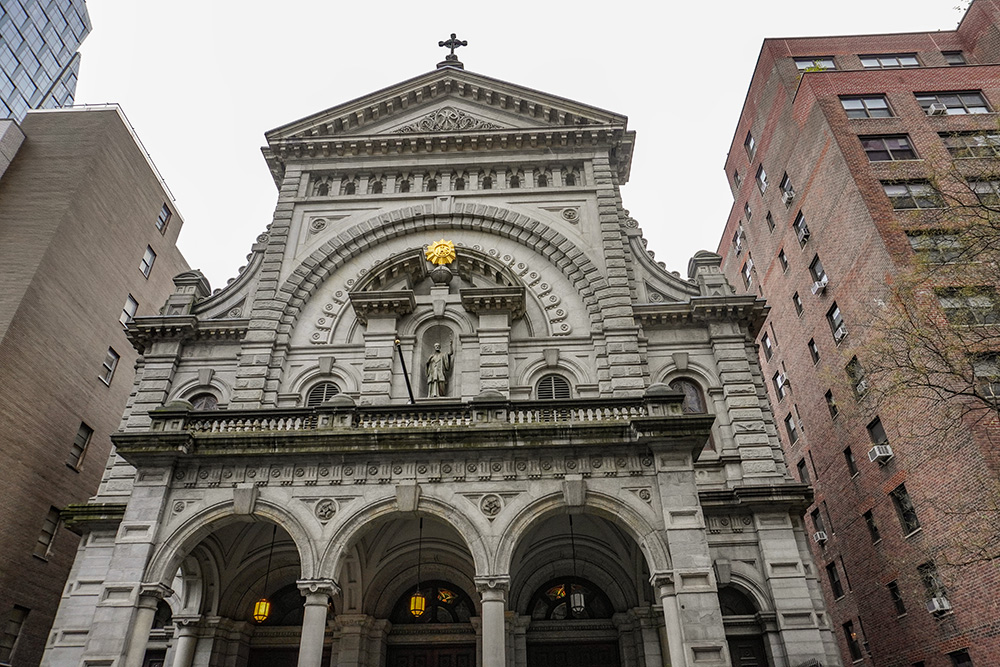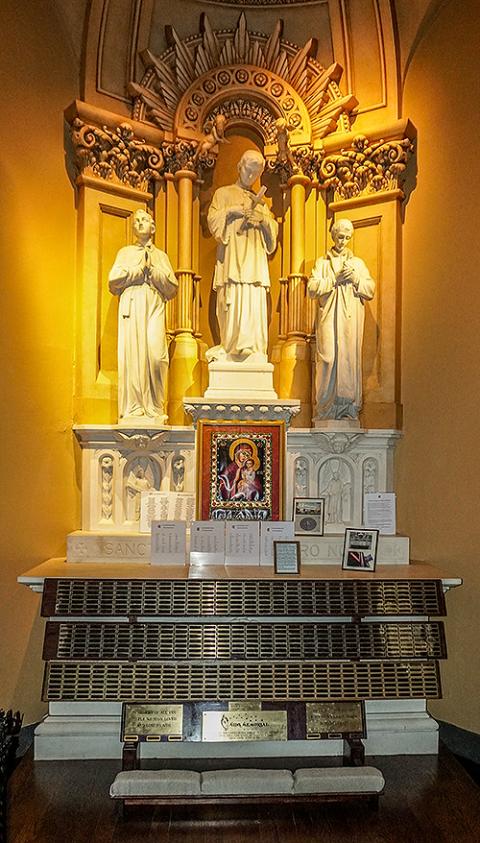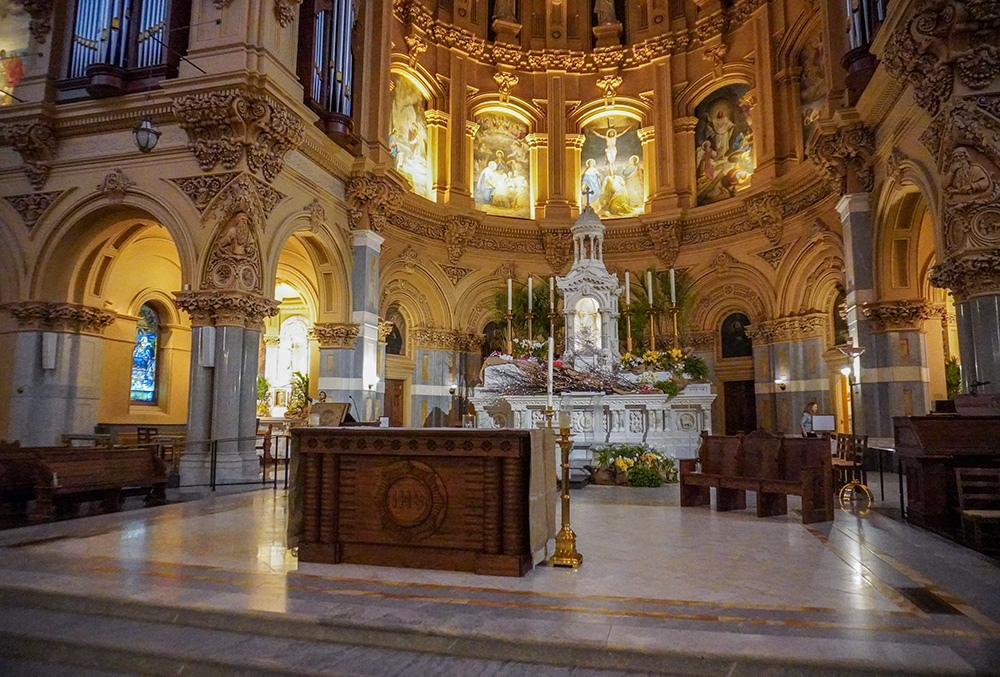
The interior of the Church of St. Francis Xavier in Manhattan, New York (NCR photo/Camillo Barone)
When Jim Hanlon, a gay New York City nurse, died in 2013 at the age of 52 from complications of HIV/AIDS, his life partner, John Uehlein, had already been director of music ministries at the Church of St. Francis Xavier in Manhattan's West Village for more than 13 years.
It was Hanlon himself who had brought Uehlein back to the church in 1999, after years of spiritual distance. On the day of Hanlon's funeral, Uehlein sat in the front pew of the church and listened to the bell choir, which he would normally direct. Six Jesuit priests concelebrated Mass, and the parish was packed with friends and relatives.
When the choir played a Celtic tune called "Pulling Bracken," Uehlein got up and sat back with the choir, in the position that would have fallen to Hanlon, to play his partner's part. At the end of the funeral, a piece of disco music blasted into the church, and all the attendees erupted in heartfelt applause as Hanlon's coffin was carried out, Uehlein told NCR.
"He brought me to St. Francis Xavier, at a time when I was probably in one of the darkest periods of my life. Not sure where I was headed, not even living at home, I was living in a halfway house," said Uehlein."That funeral was a true celebration of life."

The Church of St. Francis Xavier in Manhattan, New York (NCR photo/Camillo Barone)
Until the group ceased to exist in 2006, both Uehlein and Hanlon were active members of St. Francis Xavier's "Gonzaga Group," which gathered dozens of LGBTQ parishioners with HIV/AIDS for more than 10 years to offer spiritual support. Even today, to the left of the parish's main altar, there is a smaller altar consecrated as a memorial for all those who have died of the disease, dedicated to the Jesuit St. Aloysius Gonzaga, who for the Catholic Church is the patron saint of young people and of AIDS patients and caregivers.
In an account on the Outreach website, leadership of the parish's gay and lesbian ministries said that, in 1986, St. Francis Xavier was the first Catholic parish in the country to hold a memorial service for a man who had died of AIDS. Over the past 40 years since, it has stood out among others in the New York Archdiocese for its pastoral activities aimed at LGBTQ parishioners' inclusion, its constant liturgical and eucharistic renewal to make the sacraments more accessible to everyone, and its mission to fight racism, poverty, hunger and homelessness.
The parish has more than 20 different ministries, outreach and faith formation programs — ranging from environmental protection to racial justice, from Ignatian spiritual direction to the practice of yoga for meditating at church. Its motto is simply, "All are welcome."
"I have taken full liberty of the phrase in the general instruction in the Roman Missal where it says, 'When local customs dictate,' " said Uehlein, who today still serves as director of music ministries. He said being constantly prepared for a spiritual music repertoire that uniquely accompanies all the different groups and ministries in the parish as "a really tricky line to walk."
"The important thing is to be able to keep the music in a balanced way, so that the universal liturgy of the church is not lost," he said.
He listed some of the most important music, dance and readings programs he has created in recent years, such as "Songs for Peace," which began after the beginning of the war in Syria in 2012, and "Songs for the Earth," which was started in 2007 and then repeated every year to raise awareness about environmental care along with the local environmental ministries of the parish.
Like Ulhein, John Weber, a 68-year-old member and coordinator of the Gay Catholics group at the church, landed at the parish in the late 1990s. "Maybe this is a home that I could belong to," he recalled thinking after reading a New York Times article about the 1986 memorial for the AIDS victim.

A side altar at St. Francis Xavier is dedicated to Jesuit St. Aloysius Gonzaga, in memory of all of the parishioners who died of AIDS complications. (NCR photo/Camillo Barone)
During his first few Masses there, Weber said he felt comfortable only sitting in the back of the church, until after a few weeks he decided to pluck up his courage and sign up in November 1998 for a retreat for gay and lesbian parishioners, held in upstate New York. About 40 people attended.
"There was a full gamut of people on that retreat, who were striving for something more than what the church was able to offer," he said, adding that after the retreat his faith kept growing toward a "direction of service." Through the parish's Gay Catholic ministry, Weber writes letters to U.S. dioceses to tell them about their activities and to raise awareness about welcoming LGBTQ people into the Catholic Church.
In June 1994, both the Gay Catholics ministry and the Catholic Lesbians ministry first took part in the New York City Pride Parade, waving a large yellow parish banner. Xavier was the first Catholic parish to march under its name in the parade, the Outreach post recalled, engaging in evangelization and outreach. Since that event, Xavier has participated annually in the march, pausing only during the COVID-19 pandemic.
St. Francis Xavier is also a supporter of AIDS Walk NY, a march held once a year in May in Central Park to raise funds to support HIV prevention and treatment in underrepresented communities.
"Since Good Friday, the Catholic Church has been proclaiming the Gospels of 'Seeing and Being Seen.' Until HIV and AIDS are eradicated, those living with HIV and AIDS still need to be seen and companioned," Weber said during a post-homily reflection at a Mass at the parish on April 21.

The main altar of the Church of St. Francis Xavier in Manhattan, New York (NCR photo/Camillo Barone)
Uncovering liturgical meaning
Luz Marina Díaz, the parish's director of religious education, says it is "a prophetic parish." Since she took her role in 2007, she has so far introduced about a dozen new faith formation programs that engage children and teens of all ages as well as their parents, she said.
Every first Sunday of the month, St. Francis Xavier hosts a "family Mass," in which the pastor calls all the children to sit on the altar steps during the homily, and music is provided by an intergenerational choir composed of both parents and their children.
On other Sundays, children may participate in a separate chapel in another Mass called "Mass class," in which they are free to stop the pastor at any time during the Mass to ask questions about the liturgical meaning of each gesture and word the priest carries out.
"We want them to have a kind of a robust theology and spirituality of the Eucharist," said Jesuit Fr. James Miracky, an associate pastor.
"We've had a really robust way of opening that up for people and we're really proud of that," he said, adding that adults have asked that similar initiatives be put in place for them as well.
When children are busy with catechism after Masses, their parents are often invited to stay in the church to take part in discussions with special guests on different topics each week, such as in-depth talks on the sacrament of Eucharist, a program on Pope Francis' 2015 environmental encyclical, Laudato Si', and discussions about how to accept their children's gender and sexual identities.
Once a month, St. Francis Xavier also hosts a longer-than-usual "contemplative Mass" celebrated by Jesuit Fr. Ricardo Da Silva, another associate pastor, in which attendees are free to move, meditate and pray in silence in multiple spaces of the church.
Díaz, who also sits on the parish's interreligious committee, said that despite her church's generous openings, as a woman she has her own "struggles" with the church.
"I would like to be a deacon," she said. "I prepare parents and godparents of children to be baptized; I am the person here who organizes and schedules the baptisms, so I go through all the process. The only thing that I need is the ordination to be able to baptize, though the Catechism of the Catholic Church says that in case of emergency anyone can baptize. I would like to have that to complete the process of such a wonderful sacrament. Like me, there are many other women here that are doing many things that deacons do."
Women's participation in the life of the church was one of the most widely debated topics during the parish's meetings for the local consultations of the ongoing synod on synodality. After their discussions, the parish produced a report that was later sent to both the New York Archdiocese and the Vatican.
"One parent said in exasperation, 'My daughter can be an astronaut or a doctor. But she can't give a homily at church,' " the section of the report focusing on women in the church reads. "Another participant called the exclusion of women as priests and deacons — and the subsequent sacrifice of the insight derived from their lived experience — as a 'deep loss for every practicing Catholic.' "

A banner dedicated to the Black Lives Matter movement hangs outside the Church of St. Francis Xavier in Manhattan, New York. (NCR photo/Camillo Barone)
Seeing humanity
On March 17, a 76-year-old homeless Vietnam War veteran died after suffering a heart attack in a subway train car in downtown New York a few days earlier. When police officers tried to search for documents in his jacket to identify him, they could only find a piece of paper with a few names and phone numbers on it.*
One was that of Ralph Martin, a longtime volunteer at the soup kitchen that is held every Sunday at St. Francis Xavier, and another was that of Roxanne De La Torre, director of outreach at Xavier Mission.
Xavier Mission is a nonprofit organization that in 2012 became independent from the Church of St. Francis Xavier, where about 40 years ago a group of parishioners had decided to open a soup kitchen to help with hunger and homelessness in the neighborhood. Although today it is no longer part of the parish, Xavier Mission still operates in the parish offices and relies both on volunteers from other ministries in the parish, and on occasional volunteers coming from other parishes in New York.
According to the 2023 Xavier Mission's Impact Report, thanks to government grants, donations and more, the organization provided clean clothes to more than 1,000 guests, served about 42,000 meals every Sunday and donated another 60,000 groceries to citizens in need that year.
Advertisement
The Vietnam War veteran, who attended the soup kitchen every Sunday for more than 10 years, had no family or friends, De La Torre said. The only people he trusted were Xavier Mission volunteers and leaders, including Jesuit Fr. Kenneth Boller, the church's pastor and president of the Xavier Mission board of directors.
After about three weeks of challenging bureaucratic paperwork, Boller, De La Torre and Martin were eventually able to find a resting place for him at Calvary Cemetery, in part thanks to the help of Cardinal Timothy Dolan of New York.
"We were his family," Boller said of the veteran.
De La Torre, who organizes the mission's network of volunteers and helps staff the soup kitchen and food pantry, said its social initiatives have inspired surrounding neighborhood businesses. For instance, the organization installed "community refrigerators" on 15th Street, not far from the parish. Residents and managers of restaurants around the area are now used to putting all of their leftover food into those refrigerators, so that it cuts down on their food waste and it is also directly delivered to the people who are in need of it, "because they know it's open and free 24/7."
"What's good about working at Xavier Mission is that people are resilient," said De La Torre. "There's a lot of hopefulness, there is a lot of joy."
"At the core, from even when it was part of the parish, the goal of Xavier Mission's work was always to be in relationship with people," she said. "It wasn't just charity. It wasn't just, 'Let's just give things out.' It was instead, 'Let's see people's humanity, let's treat people the way they should be treated.' It was really rooted in Gospel values. Jesus talked about how we create places of welcome for those on the margins, and that's what the mission was created to be."
*Correction: This story was updated after initial publication to correct the veteran's date of death.











